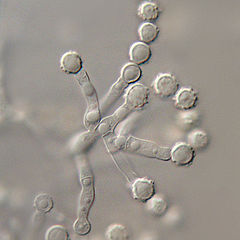Microascaceae
| Microascaceae | |
|---|---|

| |
Scopulariopsis brevicaulis
| |
| Scientific classification | |
| Kingdom: | Fungi |
| Division: | |
| Class: | |
| Order: | |
| Family: | Microascaceae Luttr. ex Malloch (1970)
|
| Type genus | |
| Microascus Zukal (1886) | |
The Microascaceae are a
History
It was introduced by Luttrell (1951) to accommodate genus Microascus which was originally placed in family Ophiostomataceae (Nannfeldt 1932,[4]) or Eurotiaceae in Eunotiales order, (Moreau and Moreau 1953;[5] Emmons and Dodge 1931;[6] Doguet 1957).[7] Then Malloch (1970) validated the family and accepted genera, Kernia, Lophotrichus and Petriellidium in the family.[2]
Sandoval-Denis et al. (2016a,
Description
Microascaceae species have spherical to irregularly shaped, darkly colored
Genera
As accepted by Wijayawardene et al. 2020 (with number of species);[3]
- Acaulium Sopp (4)
- Brachyconidiellopsis Decock, R.F. Castañeda & Adhikari (1)
- Canariomyces Arx (3)
- Cephalotrichum Link (37) - anamorph
- Doratomyces Corda (3)
- Echinobotryum Corda (2)
- Enterocarpus Locq.-Lin. (2)
- Fairmania Sacc. (1)
- Gamsia M. Morelet (5)
- Kernia Nieuwl. (14)
- Lomentospora Hennebert & B.G. Desai (1)
- Lophotrichus R.K. Benj. (8)
- Microascus Zukal (60)
- Parascedosporium Gilgado, Gené, Cano & Guarro (2)
- Petriella Curzi (8)
- Pseudallescheria Negroni & I. Fisch. (8)
- Pseudoscopulariopsis Sand.-Den., Gené & Guarro (2)
- Rhinocladium Sacc. & Marchal (11)
- Scedosporium Sacc. ex Castell. & Chalm. (12)
- Scopulariopsis Bainier (87) - anamorph
- Wardomyces F.T. Brooks & Hansf. (11)
- Wardomycopsis Udagawa & Furuya (5)
- Yunnania H.Z. Kong (3)
References
- ^ Lumbsch TH, Huhndorf SM. (December 2007). "Outline of Ascomycota – 2007". Myconet. 13. Chicago, USA: The Field Museum, Department of Botany: 1–58. Archived from the original on 2009-03-18.
- ^ JSTOR 3757662.
- ^ hdl:11336/151990.
- ^ Nannfeldt, J.A. (1932). "Studien über die Morphologie und Systematik der nichtlichenisierten inoperculaten Discomyceten". Nova Acta Regiae Soc. Sci. Upsal. Ser. IV. 8: 1–368.
- ^ Moreau, F.; Moreau, M. (1953). "Etude du développement de quelques Aspergillacées". Rev. Mycot. 18: 165–180.
- ^ Emmona, C.W.; Dodge, B.O. (1931). "The ascosporic stage of species of Scopulariopsis". Mycologia. 23: 313–331.
- ^ Doguet, G. (1957). "Organogenie du Microascus stysanophorus (Matt.) Curzi". Bull. Soc. Mycol. France. 73: 165–178.
- ^ a b c Sandoval-Denis, M.; Gené, J.; Sutton, D.A.; Cano-Lira, J.F.; de Hoog, G.S.; Decock, C.A.; Wiederhold, N.P.; Guarro, J. (2016a). "Redefining Microascus, Scopulariopsis and allied genera". Persoonia - Molecular Phylogeny and Evolution of Fungi. 36: 1–36.
- ^ a b Sandoval-Denis, M.; Gené, J.; Sutton, D.A.; Wiederhold, N.P.; Cano-Lira, J.F.; Guarro, J. (2016b). "New species of Cladosporium associated with human and animal infections". Persoonia - Molecular Phylogeny and Evolution of Fungi. 36: 281.
- ^ S2CID 219808477.
- ^ Seifert, K.A.; Gams, W. (2011). "The genera of Hyphomycetes – 2011 update". Persoonia - Molecular Phylogeny and Evolution of Fungi. 27: 119–129.
- ^ de Beer, Z.W.; Seifert, K.A.; Wingfield, M.J. (2013). "A nomenclator for ophiostomatoid genera and species in the Ophiostomatales and Microascales.". Ophiostomatoid fungi: Expanding frontiers (12 ed.). Utrecht, CBS-KNAW Fungal Biodiversity Centre.: CBS Biodiversity Series. pp. 261–268.
- ^ de Hoog G.S., Guarro J., Gené J., Figueras M.J. (2011) Atlas of clinical fungi. CD-ROM version 3.1. CBS-KNAW Fungal Biodiversity Centre, Utrecht, The Netherlands
- ^ Sandoval-Denis, M.; Sutton, D.A.; Fothergill, A.W.; Cano-Lira, J.; Gené, J.; Decock, C.A.; de Hoog, G.S.; Guarro, J. (2013). "Scopulariopsis, a poorly known opportunistic fungus: 4450 spectrum of species in clinical samples and in vitro responses to antifungal drugs". J. Clin. Microbiol. 51: 3937–3943.
- ISSN 1878-9129.
External links
 Media related to Microascaceae at Wikimedia Commons
Media related to Microascaceae at Wikimedia Commons Data related to Microascaceae at Wikispecies
Data related to Microascaceae at Wikispecies- Microascaceae in MycoBank.
